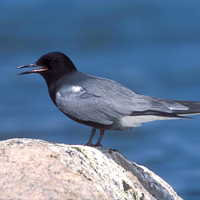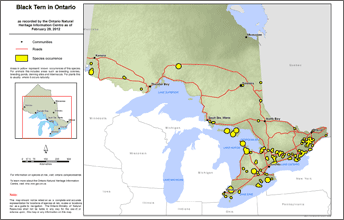Black tern
Scientific name: Chlidonias niger

Cover photo credit: Brian E. Small
Status
Special Concern
“Special Concern” means the species lives in the wild in Ontario, is not endangered or threatened, but may become threatened or endangered due to a combination of biological characteristics and identified threats.
Date added to the Species at Risk in Ontario List
The Black Tern was already assessed as a species of special concern when the Endangered Species Act took effect in 2008.
What it looks like
The Black Tern is a small, boldly marked waterbird, about 20 to 26 centimetres long, with a black head and under parts during the breeding season. Like other terns, the Black Tern has a forked tail, straight pointed bill, slender shape and long, narrow wings.
Black Terns eat mainly insects, hovering just above the water as they pick their prey off the surface.
Where it lives
Black Terns build floating nests in loose colonies in shallow marshes, especially in cattails. In winter they migrate to the coast of northern South America.
Where it’s been found in Ontario
The Black Tern breeds in the temperate regions of Europe, and in North America where it ranges from northern British Columbia and Alberta south to Arizona and Kansas and east to New Brunswick. In Ontario, Black Terns are found scattered throughout the province, but breed mainly in the marshes along the edges of the Great Lakes.
View a Larger version of this map (PDF)
What threatens it
Historical records show Black Terns were once common in Ontario, and that recent declines have been occurring since the 1980s. Threats include the draining and altering of wetlands, water pollution and human disturbance at nesting colonies – especially boat traffic, which can swamp the terns’ floating nests.
Action we are taking
Special concern species do not receive species or habitat protection.
Management plan
A management plan advises the ministry on ways to ensure healthy numbers of the species return to Ontario.
Read the management plan (June 28, 2013).
Government response statement
A government response statement outlines the actions the government intends to take or support to help recover the species.
Read the government response statement (March 7, 2014).
What you can do
Report a sighting
- Report a sighting of an endangered animal or plant to the Natural Heritage Information Centre. Photographs with specific locations or mapping coordinates are always helpful.
Volunteer
- Volunteer with your local nature club or provincial park to participate in surveys or stewardship work focused on species at risk.
Be a good steward
- Private land owners have a very important role to play in species recovery. You may be eligible for stewardship programs that support the protection and recovery of species at risk and their habitats.
Report illegal activity
- Report any illegal activity related to plants and wildlife to 1-877-TIPS-MNR (847-7667).
Quick facts
- The Black Tern is very social. It breeds in loose colonies and usually forages, roosts and migrates in flocks of a few to more than 100 birds, occasionally up to tens of thousands.
- Terns’ steady wing beats and buoyant movements have earned them the name "sea swallows".
